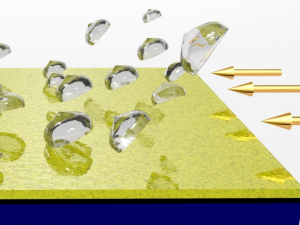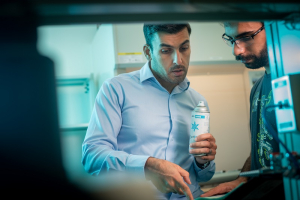Failure Could Be the Answer to Lower Costs and Higher Efficiency
While most people consider cracking, peeling, stress and other similar factors to be negatives, a group of researchers see them as opportunities to improve the fabrication of innovative functional materials.
The researchers, representing the University of Houston, the University of Toledo, Virginia Commonwealth University and York University in Canada, recently published a paper discussing their groundbreaking approach in the Royal Society of Chemistry’s journal, Materials Horizon.
“Most of the times we see defects as not good for the materials and something that should be avoided,” said Hadi Ghasemi, Bill D. Cook associate professor of mechanical engineering at the UH Cullen College of Engineering. “But we have been able to demonstrate that a wide-range of functional materials can be developed using the failure mode in an organized way.”
Parham Jafari, a UH doctoral student in mechanical engineering, also worked on the article and the research it’s based on with Ghasemi.
“In this work, we developed a new icephobic material with ice adhesion using stress-localization, which was an order of magnitude lower than that of the current state-of-the-art materials,” Jafari said. “The concept of stress-localization is far more effective than previously studied surface-modification methods.”
The Eureka Moment
Ghasemi and his UH research team, in the Nano Therm lab, are renowned for developing new materials that are anti-icing.
A lot of scientific research involves long hours, laborious work and results that don’t always turn out as expected. The idea of using failure in a positive way came about in just such a way.
Much of the team’s research focuses on creating surfaces that repel solid objects. “We wanted the surfaces to remain free of any type of contaminant – it can be ice, biofouling, scaling, dust or anything,” Ghasemi said. “The thought process we followed was: if anything undesired attaches to these surfaces, what mechanism would be needed to remove these contaminants?”
Ghasemi and his collaborators fixed on a simple answer: stress. They realized stress could be a good thing and it could be used to make materials behave in a certain way.
“It means you need to have some form of stress and failure at the interface of the surface and the contaminant,” he explained. “When something, like ice or dust, comes into contact with those surfaces, those failures or defects occur at the interface and repel those foreign objects.”
They successfully developed the idea and showed it to be effective for the anti-icing and anti-biofouling surfaces created in their lab. “We are now working to develop some other kinds of materials,” Ghasemi said.
A Synergy of Failures
Ghasemi and his team at the University of Houston weren’t alone in making a negative work for them. Talking to other researchers in the field, they found that other teams at different universities were working on similar projects focused on other negatives.
The group of multi-university researchers ended up collaborating on the published article, titled “Advanced functional surfaces through controlled damage and instabilities.” Besides stress, it identifies three other failure-oriented fabrication techniques:
Cracking and Peeling – Cracks on the surface of materials can create distinct, continuously repeating patterns on a surface. Research has shown that controlled cracking can be used to develop functional surfaces for ultra-mechnosensitive (highly sensitive) sensors and micro/nanomanufacturing, such as fabricating nanomolds or channels for nanowire manufacturing.
Peeling creates a roughness that can be used to develop superhydrophobic (water resistant) surfaces.
Sever material damage – such as abrasions, cutting or tearing can also create a rough surface that can be useful for developing hydrophobic and non-slip resistant surfaces, such as that used in footwear. This affects wettability, or a liquids ability to maintain contact with a solid surface. It can also create a surface that helps toughen ceramics.
Last, but not least, is an instability induced process, such as bucking or swelling. Usually considered a nuisance in design work, researchers have recently used buckling-induced metamaterials for soft robotics and flexible electronics with applications in displays, sensors, energy harvesting systems, actuators, anti-icing surfaces and more.
Impact
“This is a new way of thinking about material development,” Ghasemi said. “We offer a disruptive paradigm for material development that could potentially affect the future design and fabrication strategies.”
Currently, much of these functional surfaces are developed through complex and costly manufacturing approaches, such as micro/nanofabrication or laser ablation. The failure approach could open up a new avenue for faster and lower cost materials development with applications in a wide-range of fields, he said.
“From a design perspective, this approach promotes a sustainable design philosophy in materials science where ‘one man’s garbage is another man’s gold,’” Ghasemi added. “The studies presented in this article should inspire designers to include such damage and/or instability-based phenomena in materials development in an organized manner to create new design pathways in fabricating surfaces with unexpected value-added properties.”
To read the entire article, please visit: https://pubs.rsc.org/en/content/articlelanding/2019/mh/c9mh01516g#!divAbstract
Ghasemi’s team also published an article on stress-localized surfaces in the journal Soft Matter: https://pubs.rsc.org/en/content/articlelanding/2019/sm/c9sm00790c#!divAbstract

